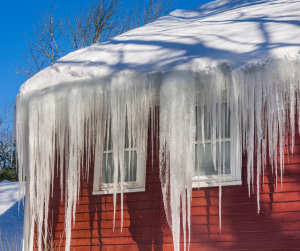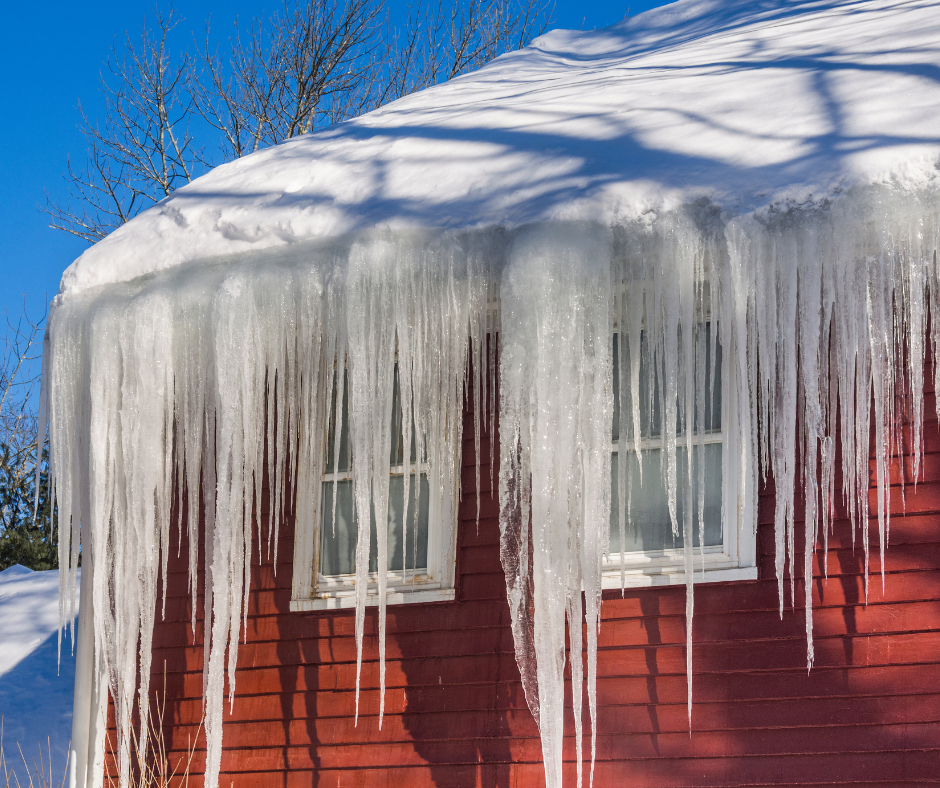
Minnesota’s winters feature a daily high-temperature average of just 29 degrees Fahrenheit, which means we’re pretty accustomed to the cold. But in a state with long, cold winters, we Minnesotans also face unique, weather-related risks!
An ice dam is one of the many threats that surround us in such cold temperatures. Understanding what they are, how to prevent them, and what to do if you do have to deal with them is key. Whether you’ve just moved here or have weathered many winters in our great state, ice dams are a reality.
As an insurance professional, I know all too well the extensive damage these ice dams can do to your home. These losses can end up as a claim on your home insurance. So, what can we do to prevent such costly damage, massive headaches, and mountains of paperwork?
What Is an Ice Dam?
An ice dam is a ridge of ice that forms along the edge of your home’s roof. Not only can these collections of ice damage a roof, but they are also known for preventing melting snow from draining off the roof’s surface.
Ice dams are caused because there is warm, moist air in your attic or space below your roof. It does not have to be a full, open attic to cause an issue. The snow on top of the roof, in certain weather conditions, begins to melt on the attic side (closest to the roof’s surface).
Water trickles down a roof’s surface, but when it reaches a colder surface, such as the eave or soffit, it refreezes. This small ice build-up grows as more melting snow and ice pile up behind it.
Why Are Ice Dams Dangerous?
As you can imagine, a build-up of ice on your roof is not a good thing. The ice buildup can back up under your roof’s shingles and cause damage. This can cause water to leak down into the ceilings and walls below.
In short, the water (melting snow) backs up, causing leaks to form in your home, and damaging walls, ceilings, insulation, or other surrounding areas. Such leaks not only ruin these surfaces but can even create a growing space for mold and mildew. Many people are allergic to these harmful spores and are known to cause respiratory problems.
Additionally, these leaks can dampen your attic’s insulation. Wet insulation does not insulate anything very well, meaning that in addition to damaged plaster (ceilings), cracking paint, and peeling walls, you also may be losing quite a bit of your heat (increased energy costs) out from your roof.
How to Deal with Ice Dams
Whew – now that we’ve talked about the seriousness of ice dams, let’s switch gears. How can you deal with ice dams?
To ensure these ice dams don’t form on your home, you will need to take some precautionary steps. If ice dams are already beginning to form, you will need to take more immediate action. If you want to prevent them (best done before freezing temperatures begin), you can take more long-term steps.
Short-Term Solutions
If you are already noticing ice dams forming, or if you fear they might begin, there are a few immediate steps that can help.
- Allow warm tap water to flow over the ice, via a hose, throughout the day
- Working from the lower level of the dam, create channels to allow drainage
- Remove the snow build-up from the roof
These short-term solutions, however, will only last hours to a few days at most. You will need to plan for longer-term methods to prevent future build-ups or worsening dams.
Long-Term Solutions
To prevent damage to your roof or in your home, you will need to take bigger steps to keep your house free from ice dams. Some of those include:
- Create a tighter, less moist air space in your attic (under your roof)
- Seal any air leaks between the home, attic, and roof
- Cut down heat loss with increased insulation in the attic space
- Check for air leaks – especially near plumbing vents, chimneys, or electrical wiring
Newer construction homes should be built to state standards, including having an air barrier throughout the ceiling.
If necessary, you can consult an energy specialist to check for air leaks, weakened insulation, or correction of heat-loss issues. These pros know how to best prevent the issue from coming back again.
How to Prevent Ice Dams
Ensuring your attic does not have any air leaks, or reinforcing any spaces where they are likely to occur (plumbing, ventilation, electrical lines, chimneys, etc.) is the best way to be sure ice dams do not return.
You may also need to assess the level of your insulation. Having the best rated product for your space will keep the heat in your home, and not seeping out through your ceilings and roof.
Lastly, keeping your roof free from heavy snow falls can prevent the issue before it begins. Roofing rakes are created to allow you to safely remove heavy snow that may damage your roofing before ice dams even form.
How NOT to Prevent Ice Dams
The state of Minnesota’s Commerce Department has a division dedicated to Energy Resources. Through this focused department, the state warns that there are steps that should NOT be taken to remove or prevent ice dams.
The state’s department says homeowners should NOT:
- Install heating cables (costly and shorten roof’s lifespan)
- Remove ice with chippers, chemicals or heat (damages structure)
- Adding roof vents (often worsens the problem with additional air leak risk)
- Rely solely on insulation (additional steps are required)
The department does recommend a high-density foam plate style of insulation for the most protection against air leaks.
Now that you know what ice dams are and how to prevent them, I hope you can take some proactive steps to protect your home! Reach out to my team if you’re concerned about having the right insurance coverage in case you do experience issues.

